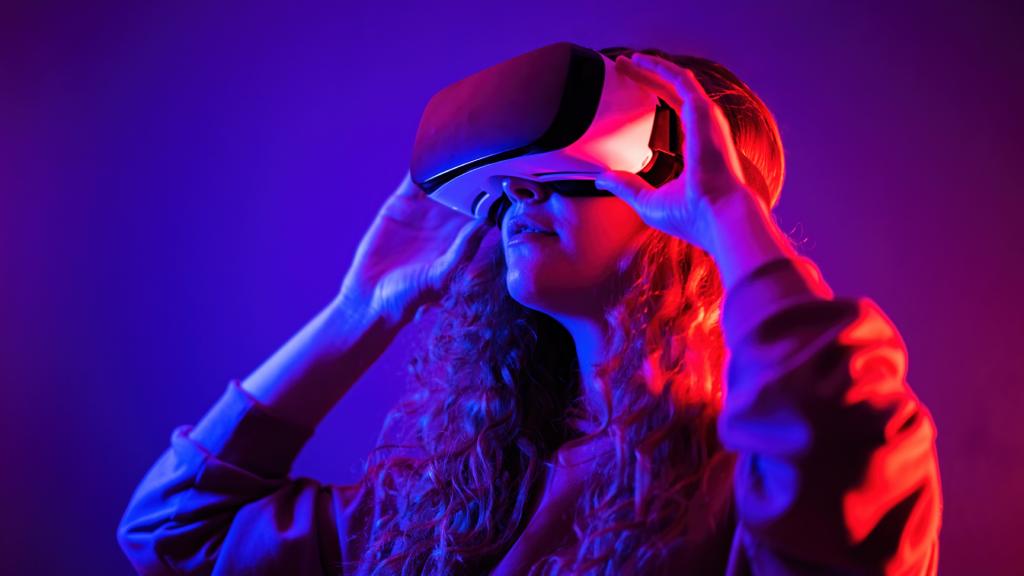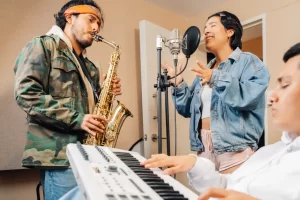The fusion of technology and music has been a transformative journey, continuously reshaping the landscape of musical expression and consumption. From the invention of the phonograph to the advent of digital streaming, each technological advancement has left an indelible mark on the music industry. Today, we stand at the cusp of a new era where technology is not just an adjunct to music but a fundamental aspect of its creation, production, and distribution. In “The Fusion of Technology and Music: Exploring New Frontiers,” we delve into the myriad ways technology continues to push the boundaries of what’s possible in music.
This fusion has given rise to entirely new genres, transformed how artists create and perform, and revolutionized how audiences engage with music. With the advent of digital tools, artificial intelligence, and virtual reality, the music world is experiencing unprecedented levels of innovation. These technologies are not only changing the sound of music but also challenging our very understanding of the creative process.
As we explore these new frontiers, questions arise about the future of music in a world increasingly dominated by technology. This blog post aims to navigate these questions, offering insights into the evolving synergy between technology and music and what it portends for artists, the industry, and listeners worldwide. Join us on this exploration of how technology continues to redefine the musical landscape, creating new experiences and possibilities for artists and audiences alike.
The Digital Revolution in Music Production
The digital revolution has radically transformed music production, shifting it from analog to digital realms. This transition has profoundly impacted how music is created, produced, and refined. In the past, recording studios were sanctuaries of analog equipment, with large mixing desks and tape machines. The move to digital technology introduced software and digital audio workstations (DAWs), making music production more accessible and versatile.
DAWs like Ableton Live, Pro Tools, and FL Studio have become the backbone of modern music production. They offer a vast array of tools and features that allow producers to manipulate audio in ways that were unimaginable in the analog era. From intricate editing to applying a myriad of effects, digital production has expanded the creative possibilities for artists.
This shift has democratized music production, enabling artists and producers to create professional-quality music from their home studios. The need for expensive studio time and equipment has diminished, allowing more people to explore music production. This accessibility has fostered a new generation of producers and artists who can experiment and publish their work independently.
Moreover, digital technology has enabled seamless integration of different music styles and elements, encouraging experimentation and genre-blending. The ease of manipulating audio digitally has led to the birth of new sounds and the evolution of existing genres, continually enriching the musical landscape.
The digital revolution in music production has not only changed how music is made but also who can make it, opening up a world of possibilities for creativity and innovation in the music industry.
The Rise of Electronic Music Genres
The rise of electronic music genres is a direct consequence of the fusion between technology and music, showcasing how technological advancements can give birth to entirely new forms of musical expression. Electronic music, in its myriad forms from house and techno to drum and bass and synth-pop, has become a cornerstone of the modern music landscape, driven by the evolution and accessibility of electronic instruments and production tools.
The genesis of electronic music can be traced back to the latter half of the 20th century with the advent of synthesizers, drum machines, and sequencers. These instruments allowed musicians to create sounds that were previously impossible, leading to the birth of genres like techno in Detroit and house music in Chicago. These genres were characterized by their use of repetitive beats, synthesized basslines, and the innovative manipulation of electronic sounds.
As technology continued to advance, so too did the scope and diversity of electronic music. The 1990s and 2000s saw the emergence of sub-genres like trance, dubstep, and EDM, each bringing its unique flavor and further pushing the boundaries of what could be achieved with electronic soundscapes. Artists and DJs became adept at using software to blend, warp, and layer sounds, creating immersive and complex auditory experiences.
The impact of electronic music extends beyond the genres themselves, influencing mainstream pop and other music styles. Elements of electronic music have been increasingly incorporated into a wide range of genres, blurring the lines between traditional musical classifications and electronic experimentation.
Today, electronic music is not just a genre; it’s a broad spectrum of sonic exploration that continues to evolve and influence. It represents the limitless possibilities that arise when technology meets creativity, symbolizing a continual reinvention of sound and a reshaping of the global musical narrative.
The Role of AI and Machine Learning in Music
The integration of Artificial Intelligence (AI) and machine learning in music represents a groundbreaking shift in the landscape of music creation and production. These technologies are opening up new frontiers, redefining the limits of what can be achieved in musical creativity and innovation.
AI in music involves algorithms that can analyze patterns in music, learn from them, and then generate new compositions or assist in the music-making process. This technology is being used in various ways, from creating background music for games and videos to helping composers and producers in generating new ideas and sounds. AI-generated music is particularly intriguing, as it challenges traditional notions of authorship and creativity, posing questions about the role of technology in the artistic process.
Machine learning, a subset of AI, has also found its way into music production. Algorithms can now master tracks, suggest improvements in mixing, or even predict future music trends based on data analysis. This technology is not only a tool for efficiency but also an avenue for creative exploration, allowing artists to interact with music in novel ways.
However, the role of AI and machine learning in music is not without controversy. While some hail these advancements as the future of music, others raise concerns about the impact on human creativity and the potential homogenization of music. Despite these debates, what’s clear is that AI and machine learning are already significantly impacting the music industry, offering both opportunities and challenges. As these technologies continue to develop, they promise to further transform the world of music, opening up a realm where human creativity and artificial intelligence collaborate to create new and unprecedented musical experiences.
Music Distribution and Streaming Platforms
The advent of music distribution and streaming platforms has revolutionized the way music is shared and consumed, marking a significant shift in the music industry landscape. This digital revolution has altered not only how music is accessed but also the dynamics of music promotion and distribution.
In the pre-digital era, music distribution was primarily through physical mediums like vinyl records, tapes, and CDs, often controlled by major record labels. The emergence of digital platforms has democratized this process, enabling artists to distribute their music directly to listeners worldwide without the need for traditional label backing. Platforms such as Bandcamp, SoundCloud, and later Spotify and Apple Music, have become essential tools for independent artists to share their music, reach new audiences, and build their careers.
Streaming services, in particular, have become a dominant mode of music consumption. They offer listeners access to vast libraries of music at their fingertips, changing the way people discover and interact with music. For artists, streaming platforms provide valuable data on listener preferences and behavior, which can inform marketing and promotional strategies.
However, this shift has also brought challenges, particularly in terms of revenue models. The streaming era has sparked debates over fair compensation for artists, with many arguing that streaming royalties often fall short of equitable payment for the music played.
Despite these challenges, digital distribution and streaming platforms continue to shape the music landscape. They represent a new era of music accessibility and consumption, where technology has made music more available and interconnected than ever before.
Virtual Reality and Augmented Reality in Music Experiences
The integration of Virtual Reality (VR) and Augmented Reality (AR) in music experiences is opening up new, immersive ways for audiences to interact with music. These technologies are transforming not just how we listen to music, but how we experience it, adding a visually dynamic layer to the auditory experience.
Virtual Reality in music allows listeners to immerse themselves in a 3D environment that responds to and enhances the music. This could be in the form of a VR concert where fans can experience a live performance virtually as if they were there, or through interactive music videos that offer a more engaging and immersive experience than traditional videos. Artists and producers are exploring VR to create unique, immersive worlds that complement their music, offering fans a deeper and more interactive connection to their work.
Augmented Reality, on the other hand, adds digital elements to the real world, enhancing the live music experience. AR apps can bring album covers to life, display lyrics in real-time during a performance, or provide additional visual elements to a live show. This technology not only enriches the fan experience but also opens up new creative avenues for artists to express their vision beyond the music.
Both VR and AR are still relatively new in the music industry, but they hold immense potential for the future. As these technologies become more accessible and sophisticated, they are poised to redefine the boundaries of musical experiences, offering new and exciting ways for artists to connect with their audience and for fans to experience music beyond just listening.
Social Media’s Influence on Music
Social media has significantly influenced the music industry, fundamentally altering how music is promoted, shared, and discovered. Platforms like Instagram, TikTok, and X have become powerful tools for artists to connect with fans, build communities, and gain exposure for their work.
One of the most notable impacts of social media on music is the ability for artists to directly engage with their audience. Through posts, stories, and live streams, musicians can share behind-the-scenes content, upcoming projects, and personal insights, creating a sense of intimacy and connection with their fans. This direct interaction has also enabled artists to build their brand and cultivate a loyal fanbase without the traditional backing of a record label.
Furthermore, social media has become a crucial platform for music discovery. Viral songs and trends on platforms like TikTok have the power to propel tracks to global popularity, regardless of the artist’s previous recognition. This democratization has opened up opportunities for emerging and independent artists, showcasing the potential for social media to launch careers.
However, the influence of social media on music also poses challenges, such as the pressure for constant content creation and the potential for rapid, but short-lived, success. Despite these challenges, the role of social media in the music industry is undeniable, offering new avenues for artists to share their music and for fans to discover and engage with it in ways that were previously impossible.
Challenges and Ethical Considerations
As technology continues to reshape the music industry, it brings with it a set of challenges and ethical considerations that artists, producers, and consumers must navigate. One of the primary concerns is the issue of copyright and intellectual property. With the ease of digital manipulation and sampling, ensuring that artists receive proper credit and compensation for their work has become increasingly complex. The proliferation of music on digital platforms also raises questions about fair revenue distribution, with many artists advocating for more equitable streaming models.
The use of AI in music production and composition introduces another layer of ethical considerations. As machine learning algorithms become more sophisticated in creating music, it challenges traditional notions of creativity and authorship. There are concerns about the potential for AI to dilute the human element in music and what that means for the future of artists and composers.
Moreover, the increasing reliance on data and analytics to drive music production and marketing strategies can lead to a homogenization of music, as artists and record labels may gravitate towards formulas that are statistically proven to be successful. This trend risks stifling creativity and diversity in music.
While technology provides numerous opportunities for innovation and accessibility in music, it also presents challenges that need to be addressed. Balancing technological advancement with fair practices and ethical considerations is crucial to ensuring that the music industry continues to thrive and evolve in a manner that respects both the art and the artists.
What’s Next for Technology and Music?
As we look towards the future, the interplay between technology and music is poised to unveil even more groundbreaking developments. The possibilities are vast, with emerging technologies set to further transform how music is created, distributed, and experienced.
One area with significant potential is the continued advancement of AI in music. Future AI could assist in more nuanced and creative ways, potentially even collaborating with artists to produce innovative compositions. However, this also raises important questions about the balance between machine-generated content and human creativity, a dialogue that will shape the ethical framework of future music production.
Another exciting frontier is the evolution of immersive technologies like VR and AR, which are expected to become more sophisticated and accessible. These technologies could redefine live performances and music videos, offering more immersive and interactive fan experiences, blurring the lines between the physical and digital worlds.
The integration of blockchain technology in music also presents a promising future, particularly in terms of fair compensation and copyright management. Blockchain’s ability to create transparent and decentralized systems could revolutionize music rights management and royalty distribution, ensuring artists are fairly compensated.
Additionally, the rise of spatial audio and 3D sound is set to change the way we experience music, offering more realistic and immersive listening experiences, potentially even personalized to the listener’s hearing profile.
The future of technology and music is a canvas for innovation, with emerging technologies offering exciting new ways to experience, create, and share music. As we venture into this future, it will be crucial to navigate these advancements thoughtfully, ensuring they enhance the musical experience while respecting the artistry and integrity of the music itself.
To Sum It Up
To sum up, the fusion of technology and music is a dynamic and ever-evolving narrative that continues to shape and redefine the music industry. From the digital revolution in music production to the advent of streaming platforms, technology has drastically altered how music is created, shared, and experienced. The rise of AI and machine learning in music composition and production marks a new frontier, offering both exciting possibilities and complex ethical considerations. Social media has become a pivotal platform for music promotion and discovery, while virtual and augmented reality are opening doors to immersive musical experiences.
As we look to the future, the interplay between technology and music promises even more groundbreaking developments. Advancements in immersive technologies, blockchain, and spatial audio are set to offer new dimensions in how we interact with music. However, as we embrace these technological advancements, challenges around copyright, fair compensation, and preserving the human element in music creation remain paramount.
The journey of music and technology is one of continual innovation and adaptation. It reflects a landscape where creativity and technology coexist, each pushing the boundaries of the other. As we move forward, the key will be to navigate this evolving terrain thoughtfully, ensuring that these technological advancements serve to enhance and enrich the world of music while respecting the artists and creators at its heart.




